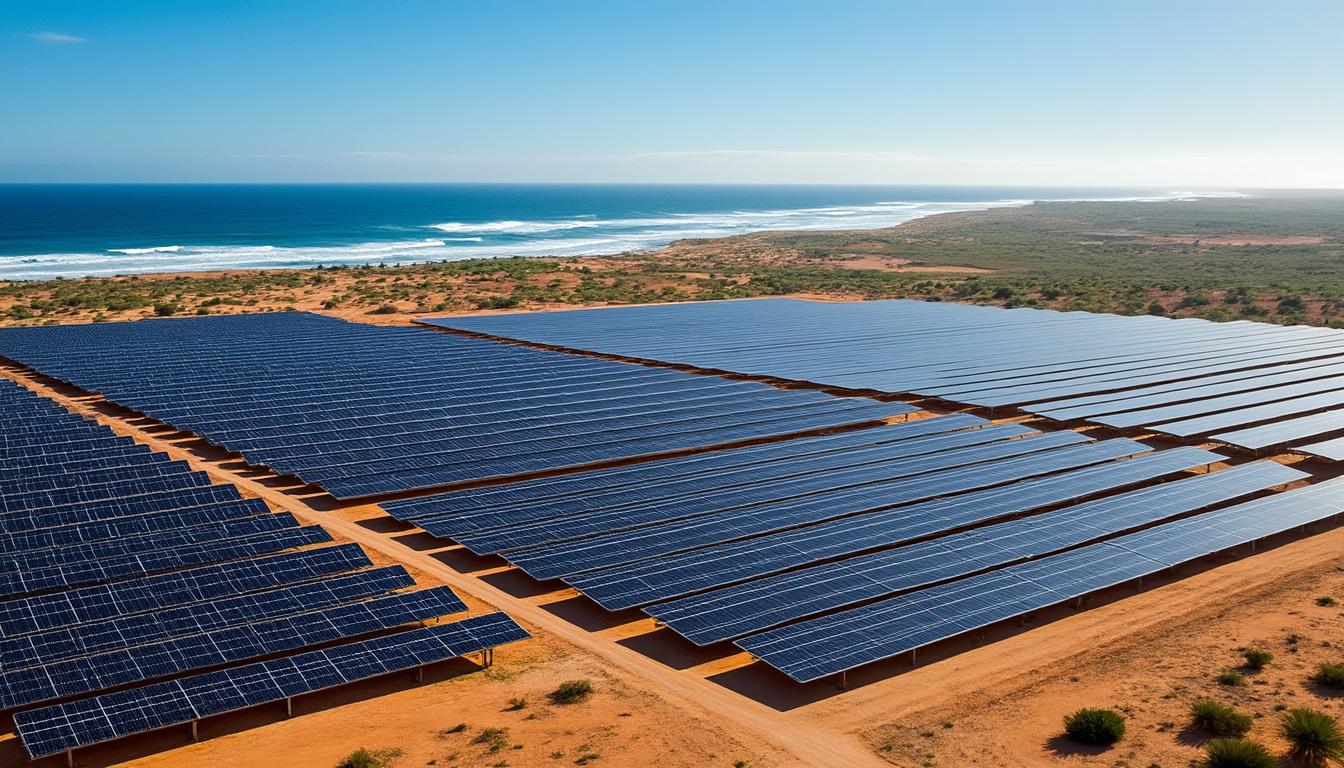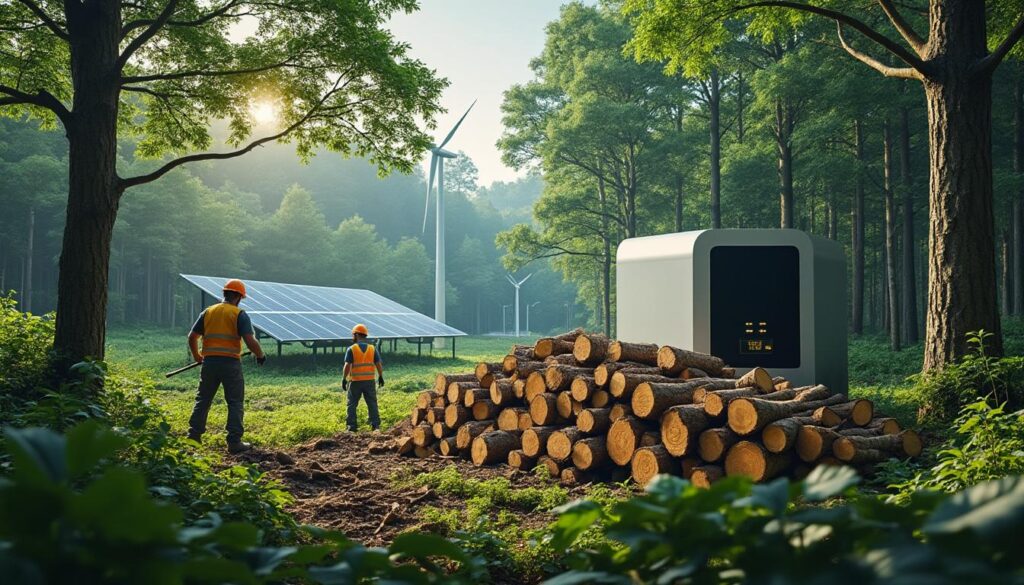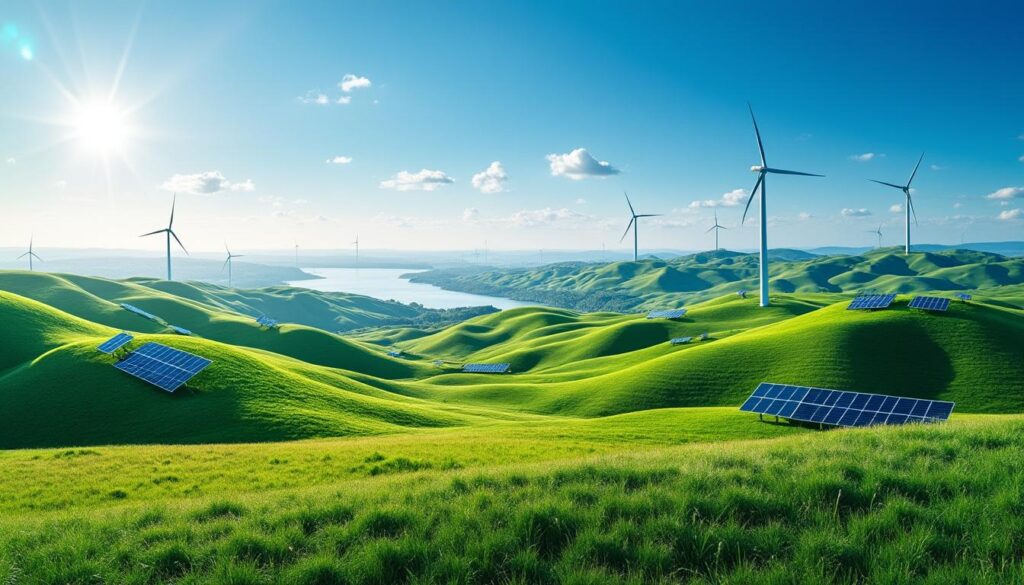The new agreement between Cape Verde and Portugal accelerates the energy transition in the archipelago by doubling the capacity of the Palmarejo solar park. For those following energy efficiency and sustainable architecture, this is a decisive step with a direct impact on energy security, the environment, and daily life.
| Short on time? Here’s the main points: |
|---|
| ✅ Doubled capacity: Palmarejo increases from 4.4 MWp to 10 MWp ⚡ — enough energy to supply 20,000 to 25,000 people 🏘️ |
| ✅ €6.8 million investment 💶 carried out by the consortium Águas de Ponta Preta (CV) + Resul (PT) 🤝 |
| ✅ Less fossil fuels, more stability in the grid, and a basis for more predictable tariffs 📉 |
| ✅ Climate and Environmental Fund (€12.5 million expanded to €42.5 million by 2030) finances projects in energy, water, agriculture, and transportation 🌿🚍 |
| ✅ Works in 2 phases: dismantling in 6 months 🛠️ + installation in 9 months 🔧, with more efficient technology 🌞 |
Immediate benefits of the Cape Verde–Portugal agreement for the Solar Park: cleaner energy, stable grid, and controlled bills
Doubling the capacity of the Palmarejo solar park means consistently reducing exposure to imported oil and its volatility. The reinforcement to 10 MWp creates a renewable cushion that allows for managing consumption peaks, stabilizing the frequency of the island grid, and, above all, preparing for the transition to a mix of 50% renewable electricity by 2030, a goal already reaffirmed by the Government. This operational gain translates into more reliable service and price predictability over time.
From the consumer’s point of view, the gains appear in three forms. First, greater quality of supply: fewer interruptions and less risk of rationing in an isolated system. Second, costs avoided from fuel and heavy maintenance in thermal plants, which lessens the pressure on tariffs. Third, creating a “solar carpet” during hours of peak irradiation encourages shifting consumption — doing laundry, heating water, charging batteries — to when solar energy is abundant and cheap to produce.
The message is consistent with what Minister Alexandre Monteiro emphasized: energy security, environmental sustainability, and economic benefits to consumers. For a family in the Palmarejo neighborhood, for example, managing appliances during the sunniest hours allows for reducing nighttime peaks and making better use of local energy, lowering the bill without high investment. A bakery using electric ovens can schedule baking batches for the period of highest photovoltaic generation, softening costs.
Operational stability and quality of service on the island grid
By reinforcing the plant, operators can work with modern inverters that offer ancillary services — voltage support and rapid response to fluctuations — vital on islands. The upgraded plant contributes to reducing technical losses and smoothing abrupt load variations. Combined with active battery management (even if distributed among customers), the plant helps to “flatten” peaks and make the demand curve more predictable.
This quality gain reduces indirect costs: fewer starts and stops at thermal plants, less wear and less fuel consumption. The grid benefits, and so does the consumer. In a scenario with volatile oil prices, every kilowatt-hour of renewable energy generated locally is insurance against external shocks.
- 🌞 Plan energy-intensive uses between 11 AM and 3 PM — that’s when solar production tends to peak.
- ⚙️ Use timers on washing machines and water heaters to take advantage of the “solar carpet.”
- 🔋 Consider home batteries or water heating by thermal accumulation as “indirect storage.”
- 🏠 Reinforce thermal insulation and shading: consuming less is always the first clean energy.
- 📱 Adopt smart plugs to automate loads during the most abundant solar period.
| Indicator ⚡ | Before (4.4 MWp) ⏳ | After (10 MWp) 🚀 |
|---|---|---|
| Installed capacity | 4.4 MWp | 10 MWp |
| Potentially supplied households | ≈ 9,000–11,000 👨👩👧 | ≈ 20,000–25,000 🏡 |
| Exposure to fossil fuels | High ⛽ | Lower 🌿 |
| Quality of supply | Vulnerable to peaks ⚠️ | More stable ✅ |
| Basis for predictable tariffs | Limited 📈 | Reinforced 📉 |
To better understand the importance of this leap, it’s worth exploring technical analyses and examples of repowering in islands with isolated grids.
Practical result: more sun in the system, less risk in supply, more opportunity for you to manage consumption intelligently.

Repowering Palmarejo: how the 6 + 9 month project will modernize and double the capacity to 10 MWp
The modernization plan for Palmarejo follows two clear phases: 6 months of dismantling the existing structure and 9 months of installation of new equipment. This approach allows for incorporating higher efficiency photovoltaic modules, inverters with better control, and anti-corrosion structures suitable for Praia’s marine environment. The result is a more compact park per megawatt, with better performance under real operating conditions.
The Águas de Ponta Preta and Resul consortium leads the execution, combining local knowledge and Portuguese engineering. This partnership is crucial for managing logistics, training teams, and post-construction maintenance. In an island context, managing maritime transport, customs, and storage is essential to avoid delaying the schedule. Therefore, planning includes delivery windows and logistical buffers to absorb unforeseen events without compromising the final deadline.
Schedule, phases, and risk mitigation
In the dismantling phase, teams remove old panels and structures, manage waste with environmental protocols, and prepare the ground for new foundations. This period is also ideal for adjusting the layout, improving access, and designing maintenance corridors that reduce risks over the lifetime. In the installation phase, high-efficiency modules and specific structures for saline environments come into play, with fasteners and profiles treated to prevent corrosion.
To mitigate risks, measures such as quality control by batch, electrical tests by strings, and commissioning in stages are adopted. The calibration of inverters and tuning of the SCADA monitoring system ensure that the plant provides reliable data from day one. Training local technicians ensures faster maintenance and a lower total cost of ownership.
- 🧭 Delivery window planning to reduce the impact of logistical delays.
- 🛡️ Anti-corrosion materials and seals suitable for coastal environments.
- 🔌 String testing and thermography to validate performance before commissioning.
- 📊 SCADA with alarms and simple dashboards for efficient local operation.
- 👷 Technical training of teams in Praia for quick response in daily operations.
| Phase 🛠️ | Duration ⏱️ | Key activities 📋 | Expected outcome ✅ |
|---|---|---|---|
| Dismantling | 6 months | Removal of modules and structures; waste management; site preparation | Site ready for new foundations and optimized layout |
| Installation | 9 months | Assembly of structures; placement of panels; inverters; cabling; SCADA | Modernized, more efficient plant ready for commissioning |
| Commissioning | Final weeks | Tests, calibration, training | Safe and stable operation from startup 🚀 |
The “secret” of repowering lies in the combination of good technical choices with organized work. The result is a leap in power, quality, and longevity of Palmarejo’s solar assets.
Conversion of debt into climate investment: the Fund that multiplied from €12.5 million to €42.5 million and what this means for you
The first project financed by the Climate and Environmental Fund arises from a simple and effective mechanism: converting part of the debt to Portugal into climate investment made in Cape Verde’s territory. The idea is to transform financial obligation into productive assets — clean energy, efficiency, water, agriculture, fishing, or transportation — with a measurable impact on reducing emissions and the country’s resilience.
The initial envelope of €12.5 million was expanded to €42.5 million with a horizon until 2030, allowing for financing various fronts. In the case of Palmarejo, the direct investment is €6.8 million, but the multiplier effect goes beyond: it creates local jobs, develops technical capacities, and reduces fuel import expenses. Every euro invested here avoids future costs and reinforces the system’s autonomy.
How it works and why it’s a model to follow
The Fund selects projects with clear and measurable environmental impact, prioritizing initiatives that reduce emissions and strengthen essential services. Governance brings together ministries, regulators, and technical partners to ensure transparency, execution, and monitoring. The agreement with Portugal serves as a model to attract other international partners interested in the same type of mechanism.
If you are a municipal manager, agricultural cooperative member, or entrepreneur, this Fund opens doors for projects that would previously be difficult to finance. There is space for well-designed microprojects — from solar water pumps to efficiency in public buildings — as long as they present impact metrics, timelines, and guaranteed maintenance.
- 📝 Define a measurable objective (kWh saved, m³ of water pumped, emissions avoided).
- 📐 Present a technical project with a timeline, OPEX, and maintenance plan.
- 🤝 Seek local partnerships for execution and operation (cooperatives, municipalities, companies).
- 🔍 Include monitoring and reporting of results (simple dashboards work).
- 💡 Plan for replicability: solutions that can be scaled to other islands.
| Area 🌍 | Financeable Examples 💶 | Direct Impact ♻️ | Social Benefit 👥 |
|---|---|---|---|
| Renewable energies | PV in public buildings; mini-grids; solar for desalination | Avoided emissions; less diesel | Continuous service and lower operational costs |
| Energy efficiency | Public LED; efficient heating; insulation | kWh saved | Thermal comfort and better urban lighting |
| Agriculture and water | Solar pumping; drip irrigation; sensors | Guaranteed water with less energy | Productivity and food security 🌾 |
| Fishing and cold storage | Solar cold chains; ice from PV | Less post-catch losses | Stable income for coastal communities 🐟 |
| Transportation | Charging for e-mobility; electric shuttle | Less local emissions | Accessible and quieter mobility 🚍 |
In summary, the conversion of debt channels resources to useful, measurable, and replicable projects — exactly the kind of investment that makes the energy transition real and tangible for you.
Water, agriculture, and mobility: how the new solar capacity opens practical opportunities in Cape Verde
With more clean and stable electricity, essential applications multiply. A direct example is the mobilization of water for agriculture and human consumption. Public tenders have already called companies — including Portuguese, isolated or in consortium with Cape Verdean — for photovoltaic pumping projects, reducing costs and dependence on diesel. In parallel, solar-powered desalination solutions are becoming more viable, especially when combined with batteries or smart load management.
In agriculture, the transition to solar pumping and efficient irrigation (such as drip systems) improves productivity while reducing wasted water. For fishing, PV-powered cold chains decrease post-catch losses and stabilize yields. In mobility, the reinforcement of the daytime “solar carpet” signals a clear opportunity to pilot electric vehicle chargers in urban areas, paving the way for public fleets and electric last-mile services.
Practical example: agricultural cooperative and secure water year-round
Imagine a cooperative in Santiago with 30 producers who today depend on diesel pumping. By installing 40–60 kWp of PV with pump controllers and a high reservoir, water can be drawn during sunny hours, ensuring nighttime availability by gravity — without large batteries. The result is lower cost per m³, fuel independence, and greater predictability for planning harvests. The same logic applies to small desalination systems in coastal villages, operating during peak solar hours.
- 🚰 Solar pumping with reservoir: store water, not just energy.
- 🌾 Precise irrigation: moisture sensors + drip irrigation to save every liter.
- 🧊 Decentralized solar cold storage: less waste and better preservation of fish.
- 🚗 Daytime charging for electric fleets and motors with abundant PV.
- 🔁 Simple maintenance: periodic cleaning of panels and filters to ensure performance.
| Use 💧 | Solar Solution 🌞 | Direct Benefit ✅ | Implementation Note 🧩 |
|---|---|---|---|
| Agricultural pumping | PV + pump controller | Less diesel; guaranteed water | High reservoir for nighttime operation |
| Desalination | PV + load management | Reduction in water costs | Operate during solar peaks; optional batteries |
| Cold storage for fishing | PV + efficient cold storage | Less post-catch losses 🐟 | Thermal insulation and maintenance of doors |
| Electric mobility | Public daytime chargers | Less emissions and noise | Integration with local grid management |
If you want to see technologies in action and nearby examples, it’s worth looking for experiences in water and energy on islands and arid areas. There is a lot of useful know-how to adapt to Cape Verde.
The more sunlight is integrated intelligently, the more resilient the real economy becomes: the one of agriculture, the sea, and day-to-day mobility for everyone.
What changes for architects, builders, and families: preparing buildings for self-consumption and taking advantage of the new solar park
With Palmarejo reinforced, it’s time to align efficient buildings and self-consumption to extract the maximum from solar kilowatts. In architecture, the basics work wonders: proper orientation, shading, cross-ventilation, and thermal mass are low-cost decisions that reduce cooling load. If consumption is lower, everything else — PV, batteries, hot water — works better and costs less.
For new homes or renovations, anticipating a roof structure for panels, cable passages, space for inverters, and, if it makes sense, a small battery simplifies future installation a lot. In condominiums, considering shared self-consumption is a way to bring solar benefits to those without their own roof. And in public buildings, the combination of PV + efficiency reduces OPEX and frees up resources for essential services.
Practical checklist for you to apply right away
Plan in three phases: consumption, production, and management. First, cut waste with simple measures — LED bulbs, efficient refrigerators, insulation on roofs. Next, assess PV on the roof with a project tailored to your usage profile. Finally, schedule loads with smart plugs, thermal accumulators, and, if possible, a small battery to shift consumption.
- 🏗️ Pre-installation: cable trays and a technical location for the inverter/battery.
- 🪟 Shade and ventilation: brises, eaves, grills for passive comfort.
- 🔌 Load management: Wi-Fi plugs and daytime schedules for appliances.
- 🌡️ Smart hot water: thermal accumulator as a “thermal battery.”
- 🔎 Monitoring: simple app to track consumption and generation.
| Action 🧰 | Time ⏱️ | Investment 💶 | Impact on the bill 📉 | Practical note 🧠 |
|---|---|---|---|---|
| LED + sealing leaks | 1–2 days | Low | Immediate reduction | First mandatory step ✅ |
| Programmable thermal accumulator | 1 day | Medium | Uses solar peak | Functions as a “battery” thermal 🌡️ |
| PV on roof (2–4 kWp) | 1–3 days | Medium–high | Significant drop in daytime costs | Tailor to consumption profile 🔍 |
| Home battery (2–5 kWh) | 1 day | Medium–high | Higher self-consumption | Optional, assess benefits 💡 |
For those involved in building design, it’s worth exploring discreet and robust solutions — ventilated roofs, natural insulations, and PV integration without compromising aesthetics. If you’re curious, there is useful content on platforms like Ecopassivehouses.pt, with ideas to adapt to the Cape Verdean context.
A simple gesture to start today: take stock of your largest daily consumptions and reschedule them for the solar period. The next step is to request a pre-study of PV for your roof — changing what depends on you unlocks the value of the new solar park for your home.
Source: www.noticiasaominuto.com


